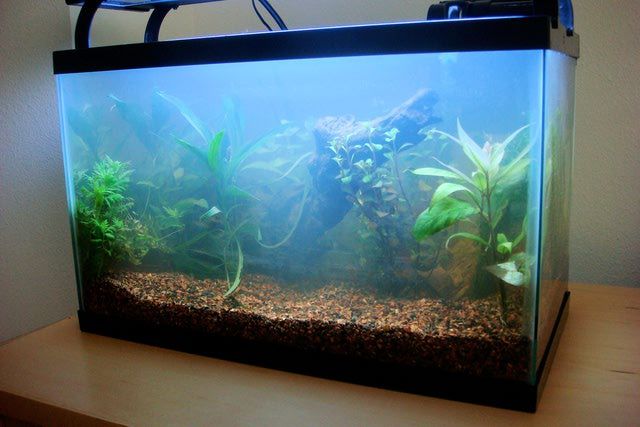Your aquarium water may be cloudy for a number of reasons, to begin it depends on the colour of the water. If it is green then most likely you have green water, an annoying type of algae that is hard to get rid of, we suggest you keep the tank out of direct sunlight, do water changes and maybe buy a UV filter.
If it is a cloudy white this can be due to a few reasons. Most likely if you have recently set up this tank, what you are seeing is a bacteria bloom that will soon pass (anywhere from 1 day to a couple of weeks). This bloom or mini cycle can also happen if you change a large amount (say more than 50%) of the tanks water or if you wash the filter media. Try to avoid doing either of these things. Overstocking and overfeeding can cause a light haze, maybe reduce both of these.
It could also be dust from a new ornament you have put in, you may need to do constant water changes to get rid of this. Substrates like Fluorite can make the tank cloudy for the first few weeks but will clear up later on.
Why are all of my fish in my aquarium starting to die?
This may be due to a number of reasons. If it is a new tank, the tank may be going through the stage of turning ammonia into nitrite, in most tanks this can and will reach toxic levels and may kill your fish, to stop this do small 10-15% water changes each day.
Other reasons could be something contaminated put into the tank recently, new rock or sculpture. Disease in some species of fish can be common; it is not unknown for a whole species of fish to suddenly die due to a breakdown in their immune system. Make sure the temperature is still high and you are feeding them a varied diet.
Check your water levels, you will probably find spikes of ammonia or nitrite in the water. Sometimes it can be more simple, if you forget to put the water conditioner on when you do a water change you have the chance of letting in toxic chlorine and chloramines, if this may be it, use some now.
Why is there so much algae in my aquarium?
Algae problems are infuriating and generally exist due to a number of reasons. There may be an unbalance of nutrients in the water, you might have too much lighting and not enough co2 and fertilizers, the plants can only consume these three in an equal ratio so having an off-balance on one will lead to an algae outbreak.
Algae may also grow on slower-growing plants like Anubis and Java Fern. This is very common and manual removal of the algae is recommended. If you have constant algae problems and are near direct sunlight try to reduce this during the day as it will be a major contributor to the amount of algae. If you feed too much or put in too much fertilizer it will once again cause an imbalance and a rise in algae.
How can I keep my gravel clean?
Each time you change the water use a gravel cleaning syphon to suck the dirt out of the substrate, rather than simply siphoning out the clean-looking water. Gravel cleaning is particularly important if the tank is fitted with an undergravel filter, since the filter bed will block unless the dirt which collects there is removed.
There are lots of gravel cleaners on the market, but a basic 5-10 one will do the job as well as anything else. Battery or air-powered gravel cleaners are rarely as effective and can't usually be used to remove water.
How can I unblock my under-gravel?
The dirt that gets drawn into the gravel bed needs to be removed regularly with a gravel cleaning siphon to prevent the bed from blocking. The bacteria which remove the pollutants in the fishes' wastes require lots of oxygen, and when the plate gets blocked the oxygen levels in the bed drop, making the bacteria less effective. If the oxygen flow to parts of the filter bed stops entirely because it's clogged with dirt, the bed will become anaerobic, and noxious gasses could build up.
To keep the filter performing at the optimum levels remove the dirt before it builds up by using a gravel cleaner every week. Periodically, insert a hose down the uplift and siphon out any detritus that has accumulated beneath the filter plate.

